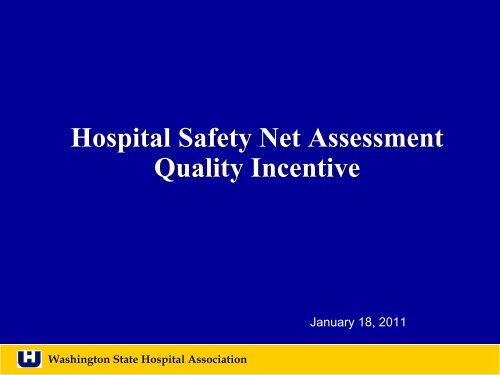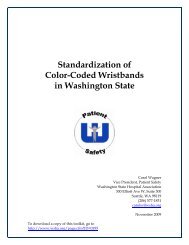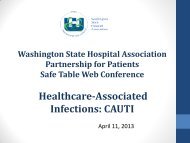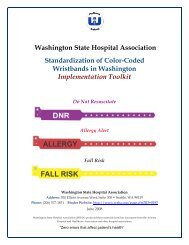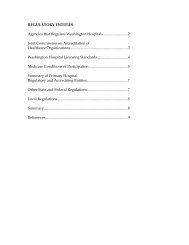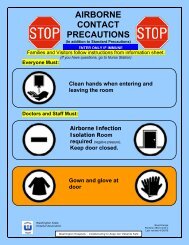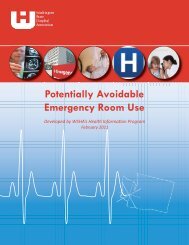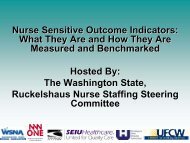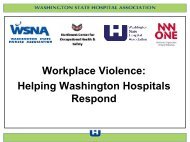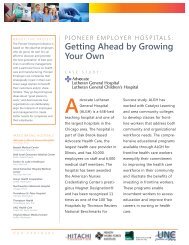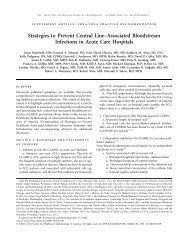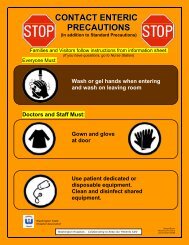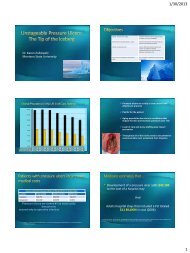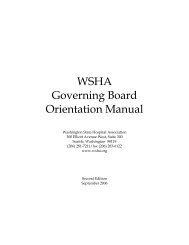View Powerpoint - Washington State Hospital Association
View Powerpoint - Washington State Hospital Association
View Powerpoint - Washington State Hospital Association
Create successful ePaper yourself
Turn your PDF publications into a flip-book with our unique Google optimized e-Paper software.
<strong>Hospital</strong> Safety Net AssessmentQuality IncentiveJanuary 18, 2011<strong>Washington</strong> <strong>State</strong> <strong>Hospital</strong> <strong>Association</strong>
PresentersCarol WagnerVice President,Patient SafetyWSHAThuy Hua‐Ly,Director,Rates & Finance,Medicaid PurchasingAdministrationClaudia SandersSenior Vice President,Policy DevelopmentWSHAAndrew BuszDirector,Financial PolicyWSHA<strong>Washington</strong> <strong>State</strong> <strong>Hospital</strong> <strong>Association</strong> 2
History: House Bill 2956 Introduced at WSHA request Safety Net Assessment increaseshospital rates –using dollars fromhospitals (assessments) and federal match Amended by Representative Cody to include a qualityincentive•July 2012: one percent increase in Medicaid inpatient rates for noncriticalaccess hospitals as “pay‐for‐performance” Passed in the 2010 legislative session<strong>Washington</strong> <strong>State</strong> <strong>Hospital</strong> <strong>Association</strong>
<strong>Washington</strong> <strong>State</strong> <strong>Hospital</strong> <strong>Association</strong>Timeline• January 2011<strong>Hospital</strong>s begin collecting performance data• January 2012Medicaid Purchasing Administration uses 2011scores to determine which hospitals qualify forpayment• Winter 2012Medicaid Purchasing Administration recalculatesassessment rates for July 1, 2012 to support stateshare of increase• July 1, 2012: Medicaid Purchasing Administrationincreases payments to qualifying hospitals
• Measures must be: Evidence‐basedLegislative Principles Consistent with national measures where possible• Methodology for earning incentive: Recognize that some measures may not be appropriate tospecialty pediatric, psychiatric, or rehabilitation hospitals Represent real improvements in quality Designed so all hospitals can earn incentive payments ifperformance is at or above the benchmark<strong>Washington</strong> <strong>State</strong> <strong>Hospital</strong> <strong>Association</strong>
Additional Framework•Measures need to be of value to Medicaidpatients. Medicare’s <strong>Hospital</strong> Compare, with heart attack andpneumonia emphasis, applies to older population.•WSHA requested measures be consistent withwhat hospitals are working to improve. Minimal additional data collection is desired.<strong>Washington</strong> <strong>State</strong> <strong>Hospital</strong> <strong>Association</strong>
Medicaid Incentive:No Good ModelsNew processBreaking new groundCollaboration between the <strong>State</strong> and clinicalexperts was essential!<strong>Washington</strong> <strong>State</strong> <strong>Hospital</strong> <strong>Association</strong>
Quality Incentive Workgroup• Developed by the Medicaid Purchasing Administration• Input from working group, which included: David Fisher, MD, Seattle Children’s Gene Peterson, MD, University of <strong>Washington</strong> Medical Center Lawrence Schecter, MD, Providence Regional Medical Center Everett Carol Wagner, RN, Claudia Sanders, Andrew Busz, WSHA staff Thuy Hua‐Ly, Jeff Thompson, MD, Mary Ann Lindeblad, RN,Bev Court, MPA staff<strong>Washington</strong> <strong>State</strong> <strong>Hospital</strong> <strong>Association</strong>
Payment Increases•One percent inpatient Medicaid increase to: APDRG Conversion Factor Per Diems Case Rates•Acute general and pediatric hospitals Receive increase across all services based onoverall hospital performance Except for those with psych units, where psychincreases based on behavioral health measures• Behavioral health hospitals and units Increase based on separate measures<strong>Washington</strong> <strong>State</strong> <strong>Hospital</strong> <strong>Association</strong>
Funding for increases• Assessments increased uniformly for non‐criticalaccess hospitals to support the payment increases• Payment increases provided to all qualifyinghospitals•No partial increases <strong>Hospital</strong>s receive either zero or one percent increase<strong>Washington</strong> <strong>State</strong> <strong>Hospital</strong> <strong>Association</strong>
Process for Selecting Measures•Clinical experts were consultedon which measures the groupshould consider• Potential measures selected byQuality Incentive Workgroup• Additional vetting with experts insetting definitions<strong>Washington</strong> <strong>State</strong> <strong>Hospital</strong> <strong>Association</strong>
<strong>Washington</strong> <strong>State</strong> <strong>Hospital</strong> <strong>Association</strong>Selected Measures:Adult, Rehab, and Pediatric Acute CareReduce <strong>Hospital</strong> Acquired Infections1. Healthcare Worker Influenza ImmunizationSafe Discharges (Reduce Rehospitalizations) – adult only2. Patient Discharge InformationSafe Deliveries (if provide service)3. Elective Delivery Prior to 39 WeeksReducing Emergency Department Cost4. Reducing Preventable Emergency Room Visits
Selected Measures:Behavioral Health ServicesReduce <strong>Hospital</strong> Acquired Infections1. Healthcare Worker Influenza ImmunizationSafe Medications2. Patients Discharged on Multiple AntipsychoticMedications with Appropriate Justification<strong>Washington</strong> <strong>State</strong> <strong>Hospital</strong> <strong>Association</strong>
Incentive Methodology• Current results used to set improvement goals• Points awarded based on performance in 2011 Depending on results, for each measure hospitals can earn 10, 5, 3,or 0 points Points averaged across all applicable measures.• <strong>Hospital</strong>s receiving an average score of 5 or above receivethe increase.• Additional recognition for hospitals that score 10 on allmeasures• All hospitals have the opportunity to earn the one percentincentive based on their results<strong>Washington</strong> <strong>State</strong> <strong>Hospital</strong> <strong>Association</strong>
Benchmark ThresholdsMeasure Threshold PointsImmunizationDischarge InfoElective Delivery80% or more 1071‐79% 561‐70% 30‐60% 086% or more 1084‐85% 582‐83% 30‐81% 07% or less 108‐17% 518‐30% 33‐100% 0<strong>Washington</strong> <strong>State</strong> <strong>Hospital</strong> <strong>Association</strong>
Benchmark ThresholdsMeasure Threshold PointsJustification onAntipsychoticsER Visits– PlanDevelopment31% or more 1021‐30 511‐20 30‐10 05 sections 104 sections 53 sections 30‐2 sections 0<strong>Washington</strong> <strong>State</strong> <strong>Hospital</strong> <strong>Association</strong>
Development of BenchmarksExample: Flu ImmunizationBaseline:Ranges were setbased on currentbaseline data.Data is measured based on the 2011 period and more hospitals can move into the higherthreshold categories.Same limits areused for the“award year”allowing allhospitalsopportunity toimprove scores andearn maximumpoints.<strong>Washington</strong> <strong>State</strong> <strong>Hospital</strong> <strong>Association</strong>
Example: Flu ImmunizationThreshold 0‐60% 61‐69 % 70‐79% 80 % or morePointAward 0 3 5 10<strong>Washington</strong> <strong>State</strong> <strong>Hospital</strong> <strong>Association</strong>
Measure Reporting• Depending on the measure, data will be reported toWSHA through: WSHA’s Quality Benchmarking System Email•The ER plan will be submitted directly to MPA•The data needs to be submitted: Quarterly for Quality Benchmarking System measures As a one‐time submission for emailed measures<strong>Washington</strong> <strong>State</strong> <strong>Hospital</strong> <strong>Association</strong>
MeasureHealthcare Worker FluImmunizationMeasure ReportingSubmission MethodEmailed to WSHAReportingFrequencyAnnually(May 1, 2011)Patient Discharge InformationElective Delivery Prior to 39WeeksReducing Preventable EmergencyRoom VisitsPatients Discharged on MultipleAntipsychotic Medications withAppropriate JustificationEmailed to WSHA(by vendor or hospital)WSHA Quality BenchmarkingSystemEmailed to Medicaid PurchasingAdministrationWSHA Quality BenchmarkingSystemQuarterlyQuarterlyAnnually(September 1,2011)Quarterly<strong>Washington</strong> <strong>State</strong> <strong>Hospital</strong> <strong>Association</strong>
<strong>Hospital</strong>s will be asked to attest to the accuracy oftheir data.<strong>Washington</strong> <strong>State</strong> <strong>Hospital</strong> <strong>Association</strong>
Measure Definitions• Based on Joint Commission, National Quality Forum,and CMS Measures•Detailed definitions available on WSHA’s website:http://bit.ly/g7FzCZ•Detailed information on the payment methodology isavailable: http://bit.ly/gpFDqj<strong>Washington</strong> <strong>State</strong> <strong>Hospital</strong> <strong>Association</strong>
Preventable Emergency Room Visits•Key issue for Medicaid Purchasing Administration 16 percent of Medicaid ER visits may be forpreventable diagnoses•Asking for hospitals to develop a plan by Sept. 1 Section 1: Community Partnerships Section 2: Data Reporting Section 3: Strategies to Prevent Unnecessary Visits Section 4: Strategies to Educate Patients Section 5: Attend educational programs<strong>Washington</strong> <strong>State</strong> <strong>Hospital</strong> <strong>Association</strong>
WSHA and MPA Collaboration• MPA will fund emergency room educationsummit Working with WSHA to develop program•WSHA will be issuing ER report Health Information Program report onpreventable visits, with key facts Educational brochure for patients<strong>Washington</strong> <strong>State</strong> <strong>Hospital</strong> <strong>Association</strong>
The Future• Assessment sunsets on July 1, 2013 But expect it will be renewed•If so, measures will be updated and revisited Revised measures? New benchmarks based on 2011 performance? ER plan likely to become measure based on percent ofpreventable visits Commitment to use measure based on cesareansection rate rather than simply elective delivery<strong>Washington</strong> <strong>State</strong> <strong>Hospital</strong> <strong>Association</strong>
Questions and CommentsCarol Wagner, carolw@wsha.org, (206) 577‐1831Claudia Sanders, claudias@wsha.org, (206) 216‐2508<strong>Washington</strong> <strong>State</strong> <strong>Hospital</strong> <strong>Association</strong> 26


